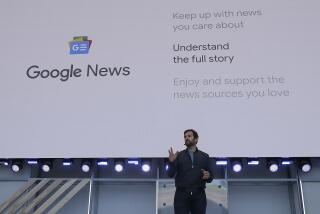Don’t Believe All You Hear on Media’s Future
Deal making in the media business continues apace. Gannett Co. agreed last week to pay $2.3 billion for Multimedia Inc., owner of newspapers, television stations and syndication rights to Phil Donahue.
Viacom sold cable properties to Tele-Communications Inc., saying it intends to be a “content-driven media company.” Content is mediaspeak for programming, as opposed to channels that carry programs.
Negotiations continued toward a sale of CBS for $5 billion.
And comment flowed coast to coast over cost cutting at Times Mirror Corp., in which Newsday’s New York offshoot was closed and cutbacks made at the Los Angeles Times.
Commentators declared it the Dickensian best and worst of times, the beginning of a new-media era in which owners of content would triumph, the end of an era with newspapers striking the flag.
But experts who know better say such talk is premature and that the world is not that simple. In the true media future, the commercial value of intellectual property--or content--will depend on the context in which it’s presented, says Esther Dyson, president of EDventure Holdings, her own technology analysis firm in New York.
Context will be king, not content--and intellectual property may fall, not rise, in value.
And media companies acquiring one another to secure a dominant position in a technology such as cable also misread the future, says Paul Saffo, technology analyst with the Institute for the Future in Menlo Park, Calif. “Information is in oversupply, not in scarcity,” he points out. “So the economies of scale are reversed, and trying to control technologies is futile.”
That means the future won’t be as neat and predictable as we think today. Indeed, the current deal making indicates that media companies are having second thoughts about how to invest for the future.
Gannett has eased out of CD-ROM activities and has been slow to commit resources to an on-line service for USA Today. Times Mirror scrapped corporate new-media efforts but retains on-line availability of the Los Angeles Times and Newsday.
There’s growing recognition that the present businesses will be around awhile. Morgan Stanley estimates that by 1998 there will still be only 16 million subscribers to on-line services, compared to roughly 100 million newspaper readers today and 98 million homes with television.
So all media, whether printed or televised, are challenged to operate the current business profitably while figuring out how to make the transition to a new world--prefigured now by the Internet and World Wide Web--in the next decade.
“A real change from the traditional newspaper business could come in 10 years, but it won’t come in five,” says analyst John Morton of Morton Research in Washington.
Newspapers remain the most economical way to distribute news and advertising, even with rising newsprint costs, which have hurt newspaper company earnings. By next year, we should see a slowing of dramatic rises in newsprint costs--70% in a year--and profitability can return, Morton says.
But it won’t return to the levels of the 1980s, when income before taxes and depreciation was typically 20% of newspaper revenue, according to statistics compiled by analyst Susan Decker of Donaldson Lufkin & Jenrette. In the future, margins of 15% and 16% will be good.
Why less profit? Markets have changed; there is more competition from other media; newspaper circulation hasn’t grown since 1990. But newspaper readers have more education and higher income levels than the population average. So the business has a good customer base--and potential.
A widely held belief is that newspapers will succeed in the computerized future because they are uniquely equipped to gather, edit and present information in comprehensible form. But that alone won’t guarantee success.
“I see business being fragmented,” says Dyson. It’s axiomatic that newspaper readers have different preferences--one buys the paper for sports, another for the crossword, or for business, foreign news, local news, etc. Advertisers often reach customers through specific sections.
In the on-line future, that practice will become more pronounced as readers go only to the sports page, crossword, etc. “There may have to be separate sponsors for sports and for crosswords,” says Dyson. Such extreme fragmentation will be a challenge for the business.
Another challenge is that information will be so plentiful, it will be hard to charge a premium for uniqueness. “Disney’s ‘Pocahontas’ is unique, and therefore Pocahontas toys and videos will sell at a premium,” Dyson says. But in the future, there will be so many cheap imitations that the value of a Pocahontas will diminish even though it remains the highest in quality.
And the future will be cheap. Right now a home page on the World Wide Web can be constructed for $100,000 and maintained for $50,000 a year, says Saffo. That means a newspaper or a specialized advertising product can be developed for the kind of money entrepreneurs borrow from relatives.
So the future will be awash in media as well as information--awash in “content.” And the way for a newspaper or television company to set itself apart is to have “a point of view, a context,” says Saffo. By that he means a worldview or manner of presenting information that readers and viewers find intelligent and congenial--and advertisers find a good environment for their presentations.
Two examples are Financial Times and MTV. Many international business people say they prefer the London-based Financial Times to the Wall Street Journal because of its foreign news.
MTV is a context for music and information because youthful audiences trust it. That’s one reason Viacom, MTV’s owner, is seen as having a better handle on the future than most media companies.
Lessons for the newspaper business are simple: The credibility attached to a newspaper’s name and the quality of its news will matter more than ever. Readers will have to trust it as the “context” of their information.
Right now, we are in a time of flux. For all the hype about a new media era, newspaper, television and cable company stocks--including Viacom--are selling at just about the market average price-earnings ratio for good, mature businesses. There is little premium for any company. Premium prices will show up when change really is imminent and managers and investors have a better idea of the true shape of the future.
*
More James Flanigan
* For a collection of recent columns by James Flanigan, sign on to the TimesLink on-line service and “jump” to keyword “James Flanigan.”
For more information on TimesLink, call (800) 792-LINK
More to Read
The biggest entertainment stories
Get our big stories about Hollywood, film, television, music, arts, culture and more right in your inbox as soon as they publish.
You may occasionally receive promotional content from the Los Angeles Times.










